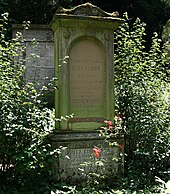August Eisenlohr (Egyptologist)
August Adolf Eisenlohr (born October 6, 1832 in Mannheim , † February 24, 1902 in Heidelberg ) was a German Egyptologist .
Life
Eisenlohr studied theology , later natural sciences , in Heidelberg and Göttingen until 1853 and was a manufacturer of chemical products for several years. He later made Egyptology his field of work. In 1869 he completed his habilitation at the University of Heidelberg for the subject of Egyptology and became an associate professor in 1872 and honorary professor in 1885 . In 1877 he made great contributions to the history of mathematics through his work on the Rhind papyrus .
The Great Harris Papyrus
During his trip to Egypt in 1869/70 he also visited AC Harris in Alexandria , who died in late 1869. Eisenlohr received permission to copy a few pages from a papyrus . When his adopted daughter and heiress Selima Harris returned to England with her entire collection of antiques , which had withstood a violent explosion of gun cotton in 1870 without major damage, and wanted to sell them, she (apparently) turned to Eisenlohr. In any case, he was in England, studied the collection carefully and compiled a catalog in Selma's house in New Brighton (Merseyside) across from Liverpool . Among them were 9 hieroglyphic and hieratic , 5 Greek papyrus scrolls and about 150 Coptic fragments. Eisenlohr spoke to Samuel Birch from the British Museum, who needed money from the British government to buy it. In 1872 this was possible.
For Eisenlohr, lecturer in ancient Egyptian language at the University of Heidelberg, the scrolls in ancient Egyptian script were of particular interest. He named the largest of the hieratic roles " The Great Harris Papyrus ". With this name he wanted to distinguish it from the papyrus translated by François Chabas in 1860 with the title "Le papyrus magique Harris" .
Eisenlohr describes "the Great Harris Papyrus":
“It is the most beautiful, largest, best-written, best-preserved of all papyrus rolls that have come to us. It is no less than 40.5 m long and 42.5 cm wide. It is now rolled up and divided into 79 sheets with an average length of 51 cm and a width of 42.5 cm. "
Eisenlohr was the first to translate the papyrus into German.
death

August Eisenlohr died on February 24, 1902 in Heidelberg. His grave is in the Heidelberg Bergfriedhof . It is still preserved today and is in the (Dept. G).
Fonts
- The great Harris papyrus . Lecture, Leipzig 1872 ( online ).
- The political condition of Egypt before the reign of Ramses III.
- A mathematical manual of the ancient Egyptians: translated and explained (Papyrus Rhind) . 2 volumes, Leipzig 1877, online at archive.org .
- Revised by Baedeker's Egypt. Part II: Upper Egypt and Nubia . Leipzig 1891.
literature
- Nikolai Stuloff: Eisenlohr, August Adolf. In: New German Biography (NDB). Volume 4, Duncker & Humblot, Berlin 1959, ISBN 3-428-00185-0 , p. 417 ( digitized version ).
Supplementary secondary literature
- Dagmar Drüll, Rectorate of the Ruprecht-Karls-Universität-Heidelberg (Hrsg.): Heidelberger Gelehrtenlexikon 1803-1932. Springer, Berlin / Heidelberg / Tokyo 2012, ISBN 978-3-642-70761-2 .
Web links
- Literature by and about August Eisenlohr in the catalog of the German National Library
- Journal of Egyptian Language and Archeology, 1885 edition From a letter from Professor Eisenlohr to Dr. Ludwig Stern on his trip to Egypt in 1867
- Proceedings of the Society Of Biblical Archeology, 1881 Edition Dr. A. Eisenlohr, Heidelberg: An Egyptian Historical Monument .
Individual evidence
- ↑ August Eisenlohr: A mathematical manual of the ancient Egyptians . (= Papyrus Rhind of the British Museum ) Hinrichs, Leipzig 1877.
| personal data | |
|---|---|
| SURNAME | Eisenlohr, August |
| ALTERNATIVE NAMES | Eisenlohr, August Adolf (full name) |
| BRIEF DESCRIPTION | German Egyptologist |
| DATE OF BIRTH | October 6, 1832 |
| PLACE OF BIRTH | Mannheim |
| DATE OF DEATH | February 24, 1902 |
| Place of death | Heidelberg |